
MAY CONTAIN NUTS

Search Shorpy
SHORPY ART

Framed or unframed, desk size to sofa size, printed by us in Arizona and Alabama since 2007. Explore now.
Join and Share
Ad-Free Shorpy
Shorpy is funded by you. Patreon contributors get an ad-free experience.
Learn more.

Recent comments
- Party of Eight?
- Good choice
- Recent view
- Hudson’s Big Store
- Say what??
- Grapes?!
- Just a Great photograph.
- A Beautiful Moment
- Such joy
- Bethune-Cookman University today
- Yellow sky at morning
- Side Winder
- Air Quality?
- Sojourner Truth riot
- None were so blind(ed)
- The less famous sister
- Good ol' days?
- Rise and Fall
- Goo Goo Ga Joob
- Ticket Retention
- Not the only one
- Vagaries of War
- Killed by Amtrak
- Back to the Future
- Wanted --
- If you can't stand the light
- Centralized Traffic Control, I believe
- What's really happening
- Heckuva remote control!
- Sometimes — Things Go Bump!
Member Photos
The Shorpy
Print Emporium
Print Emporium
Search Shorpy
Search results -- 30 results per page
- House Without Windows: 1938
- ... farmers of Mississippi bottoms." 35mm nitrate negative by Russell Lee for the Farm Security Administration. View full size.
You are my ... Posted by Dave - 04/07/2009 - 1:09pm -
![House Without Windows: 1938 May 1938. New Madrid County, Missouri. "House without windows. Home of sharecropper cut-over farmers of Mississippi bottoms." 35mm nitrate negative by Russell Lee for the Farm Security Administration. View full size.
You are my sunshineHow heartbreaking to know that these beautiful, innocent youngsters were in a home with no windows, no sunlight, no birds to look at, no flowers, trees, rain, only darkness, like solitary confinement. A home with no windows is like living in a bunker or an airplane hangar. I hope life became brighter for all of them at some point but it is difficult to see how they could have kept from getting depressed. They lived like ground moles.
ChangeSometimes things do change for the better. It's amazing what was allowed or condoned and even thought "normal" just under 75 years ago.
Cut-Over FarmersBy the 1930's, Depression-ravaged farm families - both Black and White - were moving out of the Deep South to cut bottomland timber and farm cotton on shares in the cleared land of the Missouri Delta. The sharecropper would be paid in shares to clear bottomland (much of the timber was sold for fuel or to turpentine mills). After the bottomland was cleared of timber, it would be planted in cotton and corn. Much of this bottomland soil washed away once the timber was removed - so only a few years of cash crops were possible -- then the sharecropper would move on to the next wood-lot and start over.
Though Arkansas, Louisiana, and Mississippi had more acres planted in cotton, the fields there were depleted and infested by weevils. The newly-cleared Missouri Delta cotton fields were marginal due to cooler weather, but outperformed the played-out croplands farther south. Still, the collapse of crop prices in the early 30's left many farm families living on relief or in poverty.
A good resource is "The Final Frontiers, 1880-1930: Settling the Southern Bottomlands" by John Solomon Otto.
House w/o WindowsSo they're running Linux?
A hole in the wallWindows are not the be-all and end-all. That house looks pretty decent to me. It's solid, raised, with an amazing roof (beautiful hand-cut shakes), and it's pretty large. True, they had no washing machine, microwave, toaster, internet, and the other things that make us feel superior. Eskimos in Alaska, where I'm from (and many others), lived in mostly underground sod houses without windows; did this make them less connected to nature? Now that more than half of humanity is living in cities, I think the problem is pretty much the opposite you mentioned. It's impossible to tell from this photo, but maybe that family was more loving, aware, responsible, active, and connected to nature than anyone you or I know.
In and OutI think the children probably left the house instead of staying in to play video games. The solitary confinement is a bit of a stretch, and the lack of windows might have been handy in the wintertime.
"Missouri Delta"That term threw me for a minute. I was born in Poplar Bluff and am somewhat familiar with the region even though we moved from there in my childhood. My confusion was from knowing that the Missouri River runs into the Mississippi at St. Louis, which is about 100 miles north of New Madrid. And there really is no delta there. So even for this Missourian, it was interesting to learn that bottomland of the Mississippi River as it meanders along the bootheel area of southern Missouri is indeed called the Missouri Delta. I would assume the vast expanse of the Big Muddy snaking back and forth through there gives it the look of a delta. But I'm calling it a technical misnomer, yet I wouldn't go so far as to start any arguments over it with the locals...especially since I was raised by a pair of them to be a polite gentleman.
Low paymentsTrue, it's a crummy house, but it's brand new (new boards still visible on ground) and cost little more than the labor in it. Remember labor?
Is that...the family shoe I see out in the yard?
Gimme glass!I just pictured myself walking into that scene with an old storm window with intact glass. The smiles that would light their faces as Dad and Mom ran to get tools to cut the hole into which the new Real Glass window would fit. I'm sure the glass was simply too expensive for them and it was on the Wish List alongside a fine fat turkey and a bushel of apples. As tragic as it seems that they didn't have windows, they DID have a house, and it looks like they had food, far more than far too many families then, and now.
[These people were tenant farmers, or sharecroppers. Their landlord (the property owner) would have built the shack. - Dave]
Sad but true.As sad as this picture is, as recently as 10-15 years ago there were still plenty of people living like this in "the Delta."
Not long ago, I was working not far from where this photo was taken. I was steering around an old shack in the middle of a cotton field and wondering how long it had been vacant. 1940? 1930? Surely, no one had lived in it for 50 years. The shack was identical to this shack only it had a few glassless windows, a corrugated tin roof and a porch.
After a couple days, I finally passed by when a lady was on the front porch enjoying the morning air from her rocking chair. It wasn't vacant, it was very lived in.
A funny thing about the Missouri side of the Mississippi Delta are the rural, non-engineered roads. You're driving in flat, treeless bottomland yet the roads meander all over. They began as paths meandering through the woods connecting shacks and clearings in the trees. As the shacks and trees were cleared off and the land turned to farming soybeans and corn, the meandering roads remain in place as they were 100 years ago.
The world was their "window"People then spent most of their waking hours outdoors, not cooped up inside; that was reserved for cooking and eating, doing chores like mending, and sleeping. Today, most people spend much more time inside, and even when we're outside, it's most often in a city or suburb at best, not the open country they had.
(The Gallery, Kids, Russell Lee)](https://www.shorpy.com/files/images/8a23323u.thumbnail.jpg)
- Water Boys: 1939
- ... about a dozen families. Oklahoma City, Oklahoma." Photo by Russell Lee. View full size.
General caption: ... Posted by Dave - 01/19/2020 - 8:24pm -
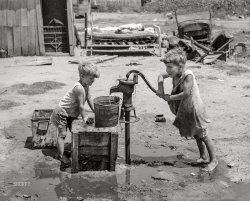
- All the Allens: 1937
- ... Black River Falls, Wisconsin." Medium format negative by Russell Lee for the Resettlement Administration. View full size.
Bug Screens ... Posted by Dave - 12/29/2014 - 12:41pm -
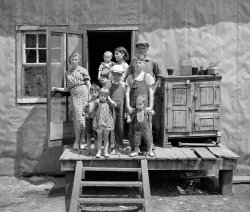
- The 8 Ball: 1940
- ... the Shasta Dam across the Sacramento River. Photo by Russell Lee for the Farm Security Administration. View full size.
Sawdust ... Posted by Dave - 12/10/2018 - 10:57am -
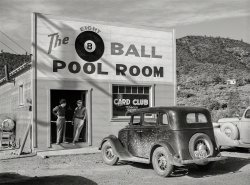
- Arterial Stop: 1937
- ... Black River Falls, Wisconsin." Medium format negative by Russell Lee for the Resettlement Administration. View full size.
Still There ... Posted by Dave - 05/21/2013 - 9:49am -
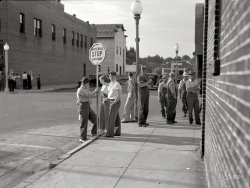
- Crunch Time: 1940
- ... Marysville, California." Medium format acetate negative by Russell Lee for the Farm Security Administration. View full size.
Leave them ... Posted by Dave - 09/30/2019 - 10:53am -
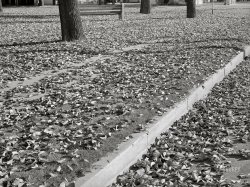
- Payasos en Penasco: 1940
- ... View full size. Medium format safety negative by Russell Lee for the FSA.
Fellini This reminds me of Fellini and "La Strada" with ... Posted by Dave - 05/05/2008 - 11:19pm -
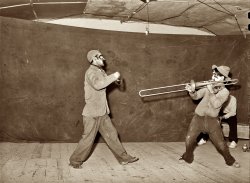
- High Water: 1937
- ... Missouri. View full size. 35mm nitrate negative by Russell Lee, Farm Security Administ'n.
Praise I just wanted to say that this ... Posted by Dave - 09/08/2011 - 9:38pm -
![High Water: 1937 January 1937. Young flood refugee asleep in a schoolhouse at Sikeston, Missouri. View full size. 35mm nitrate negative by Russell Lee, Farm Security Administ'n.
PraiseI just wanted to say that this site is absolutely great! I've been a subscriber for awhile now and love to see the artistic rawness that was life long ago. Thanks for your hard work!
[On behalf of the people who actually took the pictures, thanks! - Dave]
(The Gallery, Kids, Rural America, Russell Lee)](https://www.shorpy.com/files/images/8a21673u.thumbnail.jpg)
- Hitting the Low Notes: 1938
- ... Louisiana." View full size. Medium format negative by Russell Lee.
Bootsy Collins' Dad Double bass players have all the coolest ... Posted by Dave - 04/14/2008 - 5:44pm -
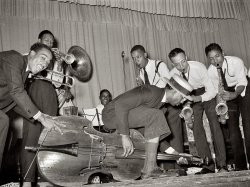
- BBQ Blessing: 1940
- ... Fair." View full size. 35mm Kodachrome transparency by Russell Lee.
(The Gallery, Pie Town, Rural America, Russell Lee) ... Posted by Dave - 09/08/2011 - 5:22pm -
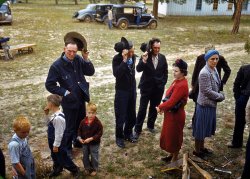
- Petro Pueblo: 1940
- ... of Penasco, New Mexico." Medium format acetate negative by Russell Lee for the Farm Security Administration. View full size.
No. 10 Steel ... Posted by Dave - 09/02/2018 - 6:05pm -
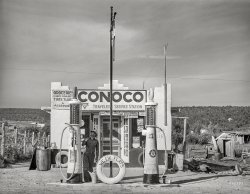
- Dairy Inspector: 1941
- ... Canyon County, Idaho." Medium format acetate negative by Russell Lee for the Farm Security Administration. View full size.
Dairy barn ... Posted by Dave - 10/20/2018 - 10:18am -
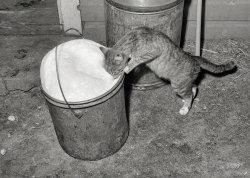
- The Wonder of It All: 1938
- ... state fair in Donaldsonville, Louisiana. 35mm negative by Russell Lee for the Farm Security Administration. View full size.
Black and ... Posted by Dave - 06/04/2008 - 3:14pm -
![The Wonder of It All: 1938 Noevember 1938. Children at the state fair in Donaldsonville, Louisiana. 35mm negative by Russell Lee for the Farm Security Administration. View full size.
Black and WhiteThis is the deep South but the crowd does not seem at all segregated. Perhaps because they are children?
[Click here. Maybe you've been watching too much TV. - Dave]
(The Gallery, Kids, Russell Lee)](https://www.shorpy.com/files/images/8a24246u_0.thumbnail.jpg)
- Parade Rest: 1938
- ... in buggy at National Rice Festival." 35mm negative by Russell Lee, Farm Security Administration. View full size.
"Oh, Shirley ... Posted by Dave - 06/08/2012 - 4:37am -
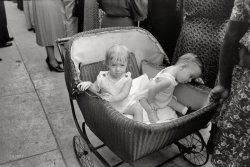
- Repairing Neatly Done: 1938
- ... door to the Good Food Cafe . 35mm nitrate negative by Russell Lee. View full size.
Chewy But Durable Any resemblance between the ... Posted by Dave - 02/18/2015 - 9:44am -
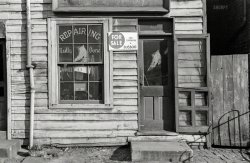
- Top Drill: 1940
- ... Labor Day celebration in Silverton, Colorado." Photo by Russell Lee. View full size.
Movie Star good looks. Kind of reminds me of ... Posted by Dave - 04/30/2020 - 2:10pm -
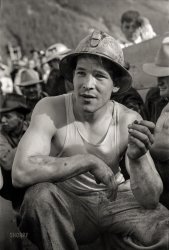
- Comic Con: 1939
- ... "Grade-school boys making books of comic strips." Photo by Russell Lee, Farm Security Administration. View full size.
Comic-strip books ... Posted by Dave - 03/21/2018 - 9:58am -
![Comic Con: 1939 The comic: "The Circus and Sue," by Claire S. Moe.
April 1939. San Augustine, Texas. "Grade-school boys making books of comic strips." Photo by Russell Lee, Farm Security Administration. View full size.
Comic-strip booksAs a kid I used to clip my favorite strip, Peanuts, and paste it into a scrapbook, the short black-and-white dailies as well as the color weekend funnies. Imagine my amazement (and retroactive feeling of wasted time) when I discovered that a publisher of books did more or less the same thing and came out with annual collections of the same strips.
Inquiring minds want to knowFirst of all, they already have books of comic strips all around them, why would they separate them and re-make them again? Was it just busy work to keep them occupied? Secondly, what is the boy using to cut out the comic strip? Those aren't like any scissors I have ever seen, nor is it a paper cutter. What is the point of this exercise?
[That's a hole punch. Capisce? - Dave]
(The Gallery, Education, Schools, Kids, Russell Lee)](https://www.shorpy.com/files/images/SHORPY-8b21696a.thumbnail.jpg)
- Do Not Disturb: 1939
- ... Good night, John-Boy. Medium-format nitrate negative by Russell Lee for the Resettlement Administration. View full size.
Long trip now, ... Posted by Dave - 01/15/2013 - 2:12pm -
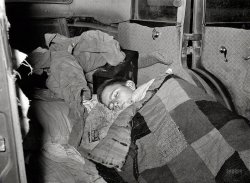
- Wednesday's Child: 1939
- ... farmer, now on WPA." Medium format acetate negative by Russell Lee for the FSA. View full size.
So you think you're poor ... Posted by Dave - 10/24/2018 - 1:10pm -
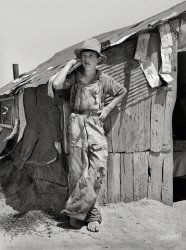
- Cauliflower Power: 1940
- ... View full size. 35mm Kodachrome transparency by Russell Lee.
(The Gallery, Pie Town, Rural America, Russell Lee) ... Posted by Dave - 09/08/2011 - 5:29pm -
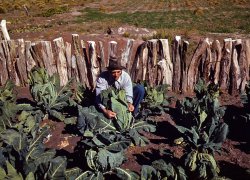
- Washings & Iornings: 1939
- ... the woman takes in washing and ironing." Photo by Russell Lee for the Farm Security Administration. View full size.
Clean and ... Posted by Dave - 05/22/2018 - 6:40pm -
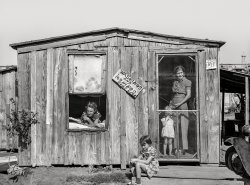
- Pie Town Ice Cream: 1940
- ... for ice." View full size. Medium-format negative by Russell Lee for the Farm Security Administration.
(The Gallery, Pie Town, Rural ... Posted by Dave - 12/30/2007 - 8:37pm -
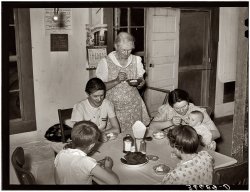
- Stovepipe Hut: 1938
- ... repairer on U.S. 90 near Jeanerette, Louisiana." Photo by Russell Lee for the FSA. View full size.
Dangerous Combination This is just ... Posted by Dave - 07/12/2014 - 2:51pm -
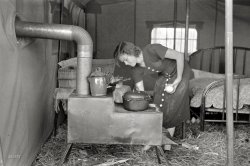
- Good EAT Food: 1938
- ... biscuits is the peeling paint! 35mm nitrate negative by Russell Lee for the Resettlement Administration. View full size.
Price Gouging ... Posted by Dave - 02/17/2015 - 9:42pm -
![Good EAT Food: 1938 January 1938. Washington, D.C. "Cafe on L Street." Where the only thing flakier than our delicious biscuits is the peeling paint! 35mm nitrate negative by Russell Lee for the Resettlement Administration. View full size.
Price Gouging25-cents is way too much to pay for chitterlings. Especially if you can get a Fish Sandwich for a dime.
Inscription on doorWhat is the writing that appears on the door? It looks Arabic.
[1841. And indeed, they are Arabic numerals! -Dave]
Questionable syntaxPut me immediately in mind of our trip to Kyoto, where we'd breakfast in a cafe called "Good Eat You".
We'd joke about putting in a reservation for Donner: "Donner, party of five . . . party of four . . . party of three . . . "
Making me hungryLiver & onions for a quarter?? Make it a double and add some mashed w/dark lumpy gravy and string beans. I'll be back tomorrow for the fried chicken!
Panoramic viewA quick stitching and we get a better view of this old building full with character.
Chincoteague oysters"1/2 dozen oysters 35 cents" ... nowadays a half-dozen Chincoteague oysters runs about $6.
This was probably L Street in SE Washington, about 200 feet from the Anacostia River.
When I was a kid my dad would stop by the wharf and buy fresh shucked oysters in big mason jars from the boats at water Street SW. Now it's turned into a fish market. You buy from shops instead of right off the boat.
I beg to differI respectfully disagree with MaltedFalcon on the location of this photo. I don't believe this can be in SE because, well, L St. SE doesn't run past 17th St. (and never has).
No, I think this has to be 1841 L St. NW. That seems to match the 1921 Baist atlas, which shows two frame structures with a narrow side yard to the east (which we see in the companion photo of the shoe store). Even though the photo above is from a later decade, it seems likely that the building in question has been there, slowly deteriorating, since well before 1921.
1957 Baist's Real Estate AtlasThe 1940 Boyd's City Directory shows 1841 L St. NW to be "Tate Louis restr", which would be a restaurant owned by Louis Tate. Also there by the same name in the classified section.
Things were different by 1957, as shown by the Baist's Real Estate Atlas of that year. Street address 1841 is now assigned to the buildings in lots 937 and 1038. There's a gas station on the corner, with a building set back from the street, like the building with the "Independent" sign in the picture.
1845 L St. NW was a filling station in the 1940 Boyd's City Directory.
(The Gallery, D.C., Eateries & Bars, Russell Lee)](https://www.shorpy.com/files/images/SHORPY-8a22615a.thumbnail.jpg)
- Curb Service: 1940
- ... factory. San Diego, California." Medium format negative by Russell Lee for the Farm Security Administration. View full size.
Here, smoke ... Posted by Dave - 08/28/2018 - 11:03am -
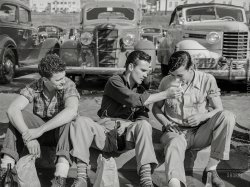
- The Oil Patch: 1939
- ... Oklahoma City, Oklahoma." Last seen here . Photo by Russell Lee for the Farm Security Administration. View full size.
Legal History ... Posted by Dave - 06/02/2018 - 12:19pm -
![The Oil Patch: 1939 August 1939. "Independent refinery. Oklahoma City, Oklahoma." Last seen here. Photo by Russell Lee for the Farm Security Administration. View full size.
Legal HistoryThe only oil company in Oklahoma at the time with "Producing & Refining Co." in their name was the Denver Producing and Refining Company. Most of the remaining information on the company is in the form of lawsuits that were lodged against it in the '30s and '40s.
[This all looks like secondhand equipment, which would explain why the DENVER (Acme, or whatever) was removed from the tank. - Dave]
Back 'a the PatchLooks like a horse racing track in the background, center, with stables in the background, right.
What's the roundish large building in the background left, with cupola? Railroad roundhouse? Indoor fairgrounds?
[Whatever it is, it is not the same building as the fairgrounds carousel. - Dave]
Oil PatchThe roundhouse is probably for indoor horse-training. Notice the really big, long building top right of center. That's an aerodrome if ever I've seen one.
[Actually that's the Stockyards Coliseum, aka the Oklahoma City Ice Palace, built in 1922, destroyed by fire in 1930, and then rebuilt with a similar design. - Dave]
The round buildingIs for walking and training horses. It is not a railroad roundhouse.
Links to the PastI believe this location is just south of the former Oklahoma State Fairgrounds, on the east side of Oklahoma City, where Douglass High School now stands. Which would put the refinery southeast of the intersection of NE Fourth Street and North Martin Luther King Avenue (former Eastern Avenue). A number of paddock buildings are visible to the southeast of the track. The body of water between the racetrack and the refinery is now part of James E. Stewart Golf Course.
(The Gallery, Industry & Public Works, OKC, Russell Lee)](https://www.shorpy.com/files/images/SHORPY-8b22680a.thumbnail.jpg)
- Mex-Tex: 1939
- ... district in Robstown, Texas." Medium format negative by Russell Lee for the Farm Security Administration. View full size.
It's A ... Posted by Dave - 01/08/2018 - 1:49pm -
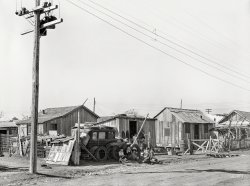
- A Fair to Remember: 1941
- ... Vale, Oregon, on the Fourth of July." Acetate negative by Russell Lee for the Farm Security Administration. View full size.
Like mother, ... Posted by Dave - 02/22/2019 - 1:09pm -
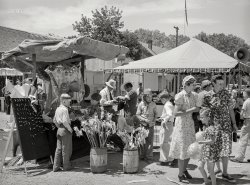
- Refugee: 1937
- ... at Sikeston, Missouri." 35mm nitrate negative by Russell Lee for the Resettlement Administration. View full size.
Flood Refugee ... Posted by Dave - 09/09/2011 - 6:33pm -
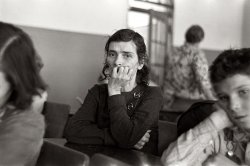
- Life With Father: 1941
- ... a painter at Consolidated Aircraft." Acetate negative by Russell Lee for the Farm Security Administration. View full size.
I married ... Posted by Dave - 05/19/2019 - 12:36pm -
![Life With Father: 1941 May 1941. San Diego. "Family living at Kearney Mesa defense housing project. This man came to California from Oklahoma 10 years ago. He has been an agricultural worker living in various FSA camps. Now employed as a painter at Consolidated Aircraft." Acetate negative by Russell Lee for the Farm Security Administration. View full size.
I married Mom?Maybe it's the hairstyle, but does anyone else think the woman looks to be much older than her husband?
What Comes Next?The photo and description begs so many questions. Did he fight in the war? Did he earn enough at Consolidated to buy her a wedding ring? Was he ever injured in an Oakland car accident? Whatever the answers, I hope they lived with few regrets and pride in their children.
ON Kearny MesaThe Kearny Mesa section of San Diego is at higher elevation than much of the city itself. Many valleys and hills in the area, thus the term 'mesa'. Picky oldtimers who know best refer to it as ON Kearny Mesa as opposed to IN. BTW, I have much family still in nearby Linda Vista (yet another common SHORPY topography reference) and my mother was in the first graduating class at Kearny High (on Kearny Mesa). Go Komets!
[You might live "on" Kearney Mesa, but you live AT the Kearney Mesa Defense Housing Project. - Dave]
Mom?If there’s one thing I’ve learned from Shorpy (amongst many, actually), it’s that women in the 1930s and 40s look a helluva lot older than they actually are. (And is it just me, or do her eyes seem to float in two entirely different planes?)
Military? Perhaps not.As Dave has pointed out, many men did not serve in the military in WW II. As a father with two children, working in what likely became a defense plant, he may have been kept stateside. My father was a supervisor at a GM factory in Michigan and while his brothers served, he stayed home.
WW2My father was a coal miner in WV and did not serve.
As we later learned, mining was almost as dangerous as the war.
(The Gallery, Kids, Russell Lee)](https://www.shorpy.com/files/images/SHORPY-8c01333a.thumbnail.jpg)























